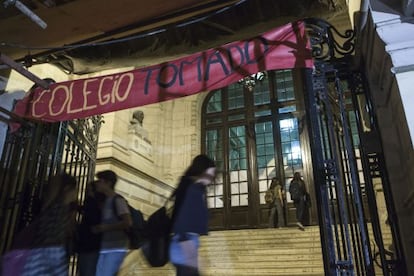Argentina’s most prestigious high school puts up a fight against reforms
Proposed changes at the National School of Buenos Aires have raised the ire of students


For 152 years, it has been the jewel in the crown of Argentina’s public school system. It is the place where all middle class families dream of sending their children.
But only the brightest are enrolled at the National School of Buenos Aires (CNBA): of the 1,000 prospective students who apply and take the entrance exams, about 400 will be accepted.
“This is a small island of excellence sat in the middle of the decadent Argentinean public school system,” says the school’s dean, Gustavo Zorzoli.
The proposed reform would, among other things, see pupils who fall behind in class thrown out
But not everything seems perfect at CNBA. For three days last week, a group of students, aged between 13 and 18, took over the school to protest against educational reforms that would, among other things, see pupils who fall behind in class expelled. This would mean that about 10 percent of the student body could be thrown out.
Because of the school’s prestige, the protest – joined by students from Carlos Pellegrini, another elite public school – captured widespread media attention. For now, it appears the students have been able to halt the reforms.
Entering the National School of Buenos Aires is like going back to Argentina’s golden period, when hundreds of thousands of hungry Europeans migrated to the South American nation.
With its large marble stairway and unique library, the neoclassical building stands at the heart of the city. Three former presidents, two Nobel prize-winners and many current politicians, including Economy Minister Axel Kicillof, graduated from CNBA.
Last Tuesday, about 300 students held an assembly to discuss how to save the school’s educational model and the country’s public education system in general.
“The school has an impressive model, which is demanding, but there are cracks,” says 16-year-old student spokesman Féliz Samoilovich. “There are social-economic barriers. If you want to get in, you have to study first at a private school, and now they want to expel more people and cancel all support study lessons.”
Julia Bozzalla, another student, claims to want to prevent the privatization of schools, as has taken place in neighboring Chile.
Three ex-presidents and two Nobel prize-winners are among the graduates of the school
“What we want is for education throughout Argentina to be like it is at this school: publicly funded, free and good quality,” she says.
Sol Gui, who is student body president, believes that the true basis for the reform is to introduce “a privatization system that will do away with public education.”
Zorzoli, the school’s rector, vehemently denies this but seems satisfied with the outcome of the protest, even though he had to sleep at the school at nights to keep the situation under control.
“The two pillars of this institution have always been its excellence – which it never lost – and political participation. Half of the candidates in the Buenos Aires primaries [which were held on Sunday] studied here,” he explains. “Argentina’s public education system has greatly deteriorated and this is troubling. The last PISA [Program for International Student Assessment] results were very bad even though a lot of money has been invested. But here we have been able to shield ourselves from all that,” Zorzoli says.
Students believe the government wants to do away with free public education in Argentina
But according to the students, CBNA’s situation isn’t all that perfect.
Like everything else in Argentina, politics plays a major role at the school, and activism that was very much alive in the 1970s has returned.
In the internal battle, where the student voting was divided, the leftwing Workers’ Party (PO) – a minority party in the national arena – has come out the winner while the “Kirchnerite” governing coalition placed third.
In Argentina, public education is a government affair. While countries in Europe, such as Germany and Britain, abandoned the free university system at the beginning of this century, Argentina has struggled to keep this model intact even after the 2001 financial crisis.
But there are no guarantees about the quality of teaching.
The government has pumped a huge amount of money into the system but the results are devastating
“All of us who are sitting at this table are children of Argentina’s free public education system,” declared Argentinean President Cristina Fernández de Kirchner this weekend in Moscow, as she pointed at her ministers who accompanied her on her official trip to Russia.
According to experts, her government has pumped huge amounts of money into the system, but the results have been a massive disappointment. The last PISA survey, in 2012, was a blow for many Argentineans, who used to claim they had the best schools in Latin America.
The country was given a middle ranking while Brazil, Chile, Mexico, Peru and Ecuador showed great improvements.
While Argentina has lost the leadership that made it a global reference point, the National School of Buenos Aires is fighting to maintain its own model.
Tu suscripción se está usando en otro dispositivo
¿Quieres añadir otro usuario a tu suscripción?
Si continúas leyendo en este dispositivo, no se podrá leer en el otro.
FlechaTu suscripción se está usando en otro dispositivo y solo puedes acceder a EL PAÍS desde un dispositivo a la vez.
Si quieres compartir tu cuenta, cambia tu suscripción a la modalidad Premium, así podrás añadir otro usuario. Cada uno accederá con su propia cuenta de email, lo que os permitirá personalizar vuestra experiencia en EL PAÍS.
¿Tienes una suscripción de empresa? Accede aquí para contratar más cuentas.
En el caso de no saber quién está usando tu cuenta, te recomendamos cambiar tu contraseña aquí.
Si decides continuar compartiendo tu cuenta, este mensaje se mostrará en tu dispositivo y en el de la otra persona que está usando tu cuenta de forma indefinida, afectando a tu experiencia de lectura. Puedes consultar aquí los términos y condiciones de la suscripción digital.
Últimas noticias
The complicated life of Francesca Albanese: A rising figure in Italy but barred from every bank by Trump’s sanctions
Reinhard Genzel, Nobel laureate in physics: ‘One-minute videos will never give you the truth’
Pinochet’s victims grapple with José Antonio Kast’s rise in Chile
How Japan is trying to avert ‘digital defeat’
Most viewed
- Pablo Escobar’s hippos: A serious environmental problem, 40 years on
- Reinhard Genzel, Nobel laureate in physics: ‘One-minute videos will never give you the truth’
- Why we lost the habit of sleeping in two segments and how that changed our sense of time
- Charles Dubouloz, mountaineering star, retires at 36 with a farewell tour inspired by Walter Bonatti
- The Florida Keys tourist paradise is besieged by immigration agents: ‘We’ve never seen anything like this’








































